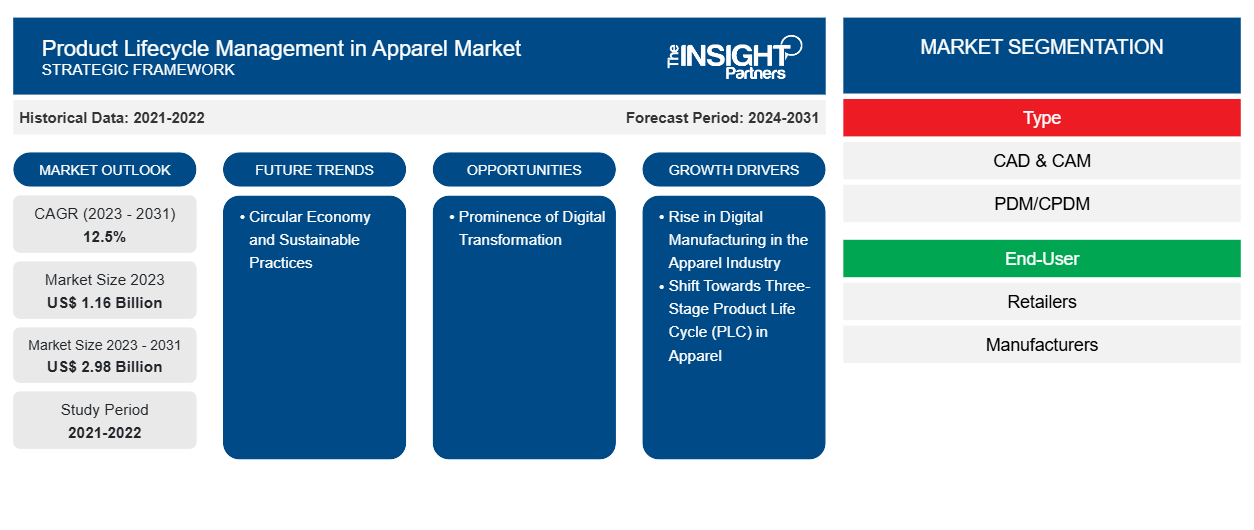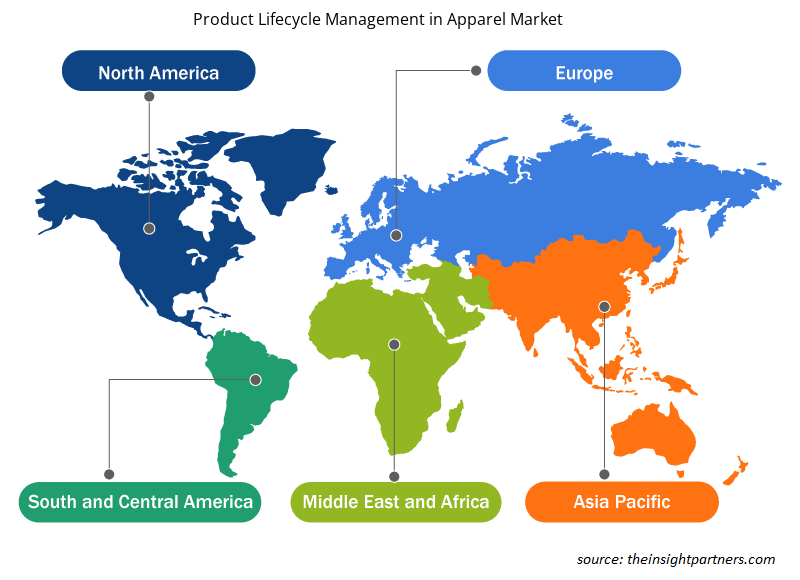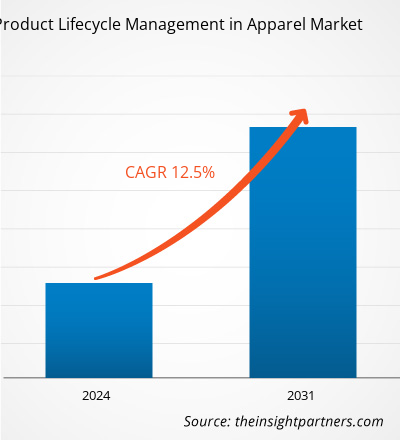Se prevé que el tamaño del mercado de la gestión del ciclo de vida del producto en la indumentaria alcance los 2.980 millones de dólares en 2031, frente a los 1.160 millones de dólares en 2023. Se espera que el mercado registre una CAGR del 12,5 % entre 2023 y 2031. Es probable que la economía circular y las prácticas sostenibles y el énfasis en la transformación digital sigan siendo tendencias clave en la gestión del ciclo de vida del producto en el mercado de la indumentaria.lifecycle management in apparel market size is projected to reach US$ 2.98 billion by 2031 from US$ 1.16 billion in 2023. The market is expected to register a CAGR of 12.5% in 2023–2031. Circular economy & sustainable practices and emphasis on digital transformation are likely to remain key product lifecycle management in apparel market trends.
Análisis del mercado de la gestión del ciclo de vida del producto en la confecciónLifecycle Management in Apparel Market Analysis
Los rápidos cambios en los gustos de los consumidores caracterizan a la industria de la moda y la reducción de la vida útil de los productos, lo que aumenta su complejidad. Estos cambios crean dificultades y perspectivas en múltiples áreas del sector, como la fabricación, los métodos de producción, los estándares y las iniciativas de publicidad y marketing.
Descripción general del mercado de la gestión del ciclo de vida del producto en prendas de vestirLifecycle Management in Apparel Market Overview
En la industria de la confección, la gestión del ciclo de vida del producto (PLM) es un enfoque estratégico para supervisar todo el recorrido de un producto, desde su diseño y desarrollo inicial hasta su lanzamiento oficial, servicio y eliminación. Este método integral implica la gestión de todas las actividades relacionadas con el ciclo de vida de un producto, como la fabricación, la comercialización y la eventual retirada del mercado. A través del enfoque PLM, la industria puede analizar la aceptación de un producto en el mercado a lo largo del tiempo, incluidas las fluctuaciones significativas en las ventas.lifecycle management (PLM) is a strategic approach to overseeing the entire journey of a product, from its initial design and development to its official launch, service, and disposal. This comprehensive method involves managing all the activities related to a product's lifecycle, such as manufacturing, marketing, and eventual removal from the market. Through the PLM approach, the industry can analyze how well a product is received by the market over time, including significant fluctuations in sales.
Personalice este informe según sus necesidades
Obtendrá personalización en cualquier informe, sin cargo, incluidas partes de este informe o análisis a nivel de país, paquete de datos de Excel, así como también grandes ofertas y descuentos para empresas emergentes y universidades.
Gestión del ciclo de vida del producto en el mercado de la confección: perspectivas estratégicasLifecycle Management in Apparel Market:

- Obtenga las principales tendencias clave del mercado de este informe.Esta muestra GRATUITA incluirá análisis de datos, desde tendencias del mercado hasta estimaciones y pronósticos.
Gestión del ciclo de vida del producto en el mercado de la confección: factores impulsores y oportunidadesLifecycle Management in Apparel Market Drivers and Opportunities
El auge de la fabricación digital en la industria de la confección impulsará el mercado
Se espera que el auge de la fabricación digital en la industria de la confección tenga un impacto significativo en la necesidad de sistemas de gestión del ciclo de vida del producto (PLM) robustos y confiables. Esto se debe en gran medida a los complejos procesos involucrados en la fabricación digital, que incluyen la concepción, el diseño, la planificación y la ejecución, todos los cuales requieren un uso extensivo de software PLM como CAD y CAM. Como resultado, se prevé que la expansión de la fabricación digital impulse la necesidad de sistemas PLM, impulsando así el progreso de la gestión del ciclo de vida del producto en el mercado de la confección durante el período previsto.lifecycle management (PLM) systems. This is largely due to the complex processes involved in digital manufacturing, including conception, design, planning, and execution, all of which require extensive use of PLM PLM systems, thus driving the progress of product lifecycle management in the apparel market over the forecasted period.
Prominencia de la transformación digital
El cambio continuo hacia la digitalización ha abierto nuevas vías para la innovación, incorporando tecnologías avanzadas como el aprendizaje automático (ML), la inteligencia artificial (IA), la robótica y la Internet de las cosas (IdC) para liderar el camino hacia la era de la cuarta revolución industrial (Industria 4.0). En la Industria 4.0, la combinación de la electrónica y la tecnología de la información facilita la integración digital perfecta de los aspectos físicos, digitales y biológicos de la vida humana moderna. Esto marca un cambio significativo para la industria manufacturera, en particular en la producción de bienes fabricados en masa como ropa y calzado, ya que la Industria 4.0 impulsa una transformación revolucionaria. digitalization has opened up new avenues for innovation, incorporating advanced technologies such as machine learning (ML), artificial intelligence (AI), robotics, and the Internet of Things (IoT) to lead the way into the era of the fourth industrial revolution (Industry 4.0). In Industry 4.0, the blending of electronics and information technology facilitates the seamless digital integration of the physical, digital, and biological aspects of modern human life. This marks a significant change for the manufacturing industry, particularly in the production of mass-manufactured goods like clothing and footwear, as Industry 4.0 instigates a revolutionary transformation.
Análisis de segmentación del informe de mercado de gestión del ciclo de vida del producto en prendas de vestir
Los segmentos clave que contribuyeron a la derivación de la gestión del ciclo de vida del producto en el análisis del mercado de prendas de vestir son el tipo y el usuario final.
- Según el tipo, el mercado se divide en CAD & CAM y PDM/CPDM. El segmento CAD & CAM tuvo una participación de mercado significativa en 2023.
- En términos de usuarios finales, el mercado está segmentado en minoristas,Fabricantes y otros. El segmento de fabricantes tuvo una participación sustancial del mercado en 2023.
Análisis de la cuota de mercado de la gestión del ciclo de vida del producto en el sector de la confección por geografía
El alcance geográfico del informe de mercado sobre gestión del ciclo de vida del producto en prendas de vestir se divide principalmente en cinco regiones: América del Norte, Asia Pacífico, Europa, Medio Oriente y África, y América del Sur/América del Sur y Central.
La gestión del ciclo de vida de los productos en el mercado de la confección en Europa abarca la gestión de todo el ciclo de vida de los productos de moda, abordando los desafíos únicos que plantean las tendencias cambiantes y las preferencias de los consumidores. Se espera que el mercado experimente un crecimiento significativo y la adaptación a la dinámica cambiante del mercado presenta oportunidades para las empresas de la industria de la confección europea.
Perspectivas regionales sobre la gestión del ciclo de vida del producto en el mercado de la indumentaria
Los analistas de Insight Partners explicaron en detalle las tendencias y los factores regionales que influyen en la gestión del ciclo de vida del producto en el mercado de prendas de vestir durante el período de pronóstico. Esta sección también analiza los segmentos y la geografía de la gestión del ciclo de vida del producto en el mercado de prendas de vestir en América del Norte, Europa, Asia Pacífico, Oriente Medio y África, y América del Sur y Central.

- Obtenga datos regionales específicos para la gestión del ciclo de vida del producto en el mercado de la indumentaria
Alcance del informe de mercado sobre gestión del ciclo de vida del producto en prendas de vestir
| Atributo del informe | Detalles |
|---|---|
| Tamaño del mercado en 2023 | 1.160 millones de dólares estadounidenses |
| Tamaño del mercado en 2031 | US$ 2.98 mil millones |
| CAGR global (2023 - 2031) | 12,5% |
| Datos históricos | 2021-2022 |
| Período de pronóstico | 2024-2031 |
| Segmentos cubiertos | Por tipo
|
| Regiones y países cubiertos | América del norte
|
| Líderes del mercado y perfiles de empresas clave |
|
Densidad de actores del mercado: comprensión de su impacto en la dinámica empresarial
El mercado de la gestión del ciclo de vida del producto en el sector de la confección está creciendo rápidamente, impulsado por la creciente demanda de los usuarios finales debido a factores como la evolución de las preferencias de los consumidores, los avances tecnológicos y una mayor conciencia de los beneficios del producto. A medida que aumenta la demanda, las empresas amplían sus ofertas, innovan para satisfacer las necesidades de los consumidores y aprovechan las tendencias emergentes, lo que impulsa aún más el crecimiento del mercado.
La densidad de actores del mercado se refiere a la distribución de las empresas o firmas que operan dentro de un mercado o industria en particular. Indica cuántos competidores (actores del mercado) están presentes en un espacio de mercado determinado en relación con su tamaño o valor total de mercado.
Las principales empresas que operan en el mercado de gestión del ciclo de vida del producto en prendas de vestir son:
- C-DISEÑO Moda
- Solución generada por computadora
- Dassault Sistemas
- Optitex EFI
- Tecnología Gerber LLC
- Infor Inc.
Descargo de responsabilidad : Las empresas enumeradas anteriormente no están clasificadas en ningún orden particular.

- Obtenga una descripción general de los principales actores clave del mercado de gestión del ciclo de vida del producto en prendas de vestir
Gestión del ciclo de vida del producto en el mercado de la confección: novedades y novedades
La gestión del ciclo de vida del producto en el mercado de la indumentaria se evalúa mediante la recopilación de datos cualitativos y cuantitativos a partir de investigaciones primarias y secundarias, que incluyen importantes publicaciones corporativas, datos de asociaciones y bases de datos. A continuación, se incluye una lista de los avances en el mercado:
- Aptean, un proveedor global de soluciones de software empresarial de misión crítica, anunció la adquisición de Momentis, un proveedor de soluciones de software diseñadas específicamente para las industrias de moda, indumentaria, calzado, textiles y accesorios.
(Fuente: Aptean Inc., comunicado de prensa, 2024)
- Infor®, la empresa de servicios en la nube para la industria, anunció hoy la disponibilidad de una interfaz dedicada entre Made2Flow, una empresa de tecnología especializada en el análisis y validación de datos ambientales en la industria de la moda, y la gestión del ciclo de vida del producto (PLM) de Infor. La interfaz facilitará el procesamiento de datos y la visibilidad total para las marcas de moda globales que buscan aumentar la transparencia de la cadena de suministro de producción. Fundamentalmente, respaldará la trazabilidad y la medición del impacto en los niveles uno a cuatro.
(Fuente: Infor, Nota de Prensa, 2023)
Informe de mercado sobre gestión del ciclo de vida del producto en prendas de vestir: cobertura y resultados
El informe “Gestión del ciclo de vida del producto en la indumentaria Tamaño del mercado y pronóstico (2021-2031)” proporciona un análisis detallado del mercado que cubre las siguientes áreas:
- Tamaño del mercado y pronóstico a nivel global, regional y nacional para todos los segmentos clave del mercado cubiertos bajo el alcance
- Dinámica del mercado, como impulsores, restricciones y oportunidades clave
- Principales tendencias futuras
- Análisis detallado de las cinco fuerzas de Porter y PEST y FODA
- Análisis del mercado global y regional que cubre las tendencias clave del mercado, los principales actores, las regulaciones y los desarrollos recientes del mercado.
- Análisis del panorama de la industria y de la competencia que abarca la concentración del mercado, el análisis de mapas de calor, los actores destacados y los desarrollos recientes
- Perfiles detallados de empresas
- Análisis histórico (2 años), año base, pronóstico (7 años) con CAGR
- Análisis PEST y FODA
- Tamaño del mercado, valor/volumen: global, regional y nacional
- Industria y panorama competitivo
- Conjunto de datos de Excel
Informes recientes
Informes relacionados
Testimonios
Razón para comprar
- Toma de decisiones informada
- Comprensión de la dinámica del mercado
- Análisis competitivo
- Información sobre clientes
- Pronósticos del mercado
- Mitigación de riesgos
- Planificación estratégica
- Justificación de la inversión
- Identificación de mercados emergentes
- Mejora de las estrategias de marketing
- Impulso de la eficiencia operativa
- Alineación con las tendencias regulatorias






















 Obtenga una muestra gratuita para - Gestión del ciclo de vida del producto en el mercado textil
Obtenga una muestra gratuita para - Gestión del ciclo de vida del producto en el mercado textil